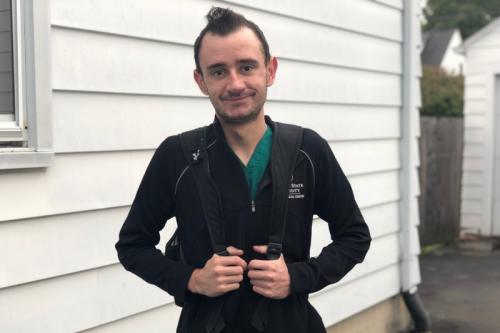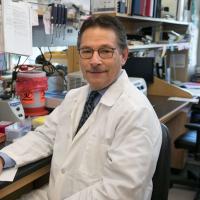
Young man who underwent gene therapy for an immune system deficiency gives back by working in hospital during COVID-19 pandemic
Long before the COVID-19 pandemic, Brenden Whittaker was well-accustomed to the measures necessary to prevent the spread of infection – and then some.
From the time he was a small child, Whittaker had to move through the world with the awareness that for him, life-threatening infections were everywhere. He couldn’t swim in the ocean or a lake because unchlorinated water can contain organisms that, while harmless to the average person, could send Whittaker to the hospital. Even something as simple as playing with his beagle, Rascal, in the grass in his backyard was off the table.
That’s because Whittaker was born with X-linked chronic granulomatous disease (X-CGD), a rare genetic blood disorder that left him unable to fight off common germs, specifically bacteria and fungi, and prone to getting very sick from infections that would be mild for healthy people.
Despite his best efforts to wash his hands and avoid high-risk activities, Whittaker suffered from life-threatening infections that required him to be hospitalized hundreds of times. At age 16, he had a particularly bad case of pneumonia that left him with a 106 degree fever for two straight weeks.
“I was starting to plan my funeral,” Whittaker, now 27, said. “I didn’t think there was going to be another option for me at that point.”
When this severe case of pneumonia kept returning, Whittaker’s doctors had no choice but to cut the infected tissue from his right lung. A few years later, an infected part of his liver followed. By age 22, the cocktail of antibiotics and immune boosters Whittaker had received via daily IV injections to fight off infections had stopped working entirely.
The only other treatment option for people with X-CGD is a bone marrow transplant from a matched donor. For Whittaker, no matched donor could be found.
That’s when Whittaker’s doctors told him about a clinical trial for a new blood stem cell gene therapy for X-CGD led at three sites around the United States by Dr. Donald Kohn, a distinguished professor of microbiology, immunology and molecular genetics and member of the Eli and Edythe Broad Center of Regenerative Medicine and Stem Cell Research at UCLA.
Developed by a group in Europe and based on principles proven in Dr. Kohn’s stem cell gene therapy for severe combined immunodeficiency, also known as bubble baby disease, the new treatment would entail removing Whittaker’s blood-forming stem cells, modifying the cells in the laboratory to correct the genetic mutation that caused the disease and returning the modified cells to Whittaker.
Whittaker was given the opportunity to become patient number one in the trial, which was funded by the National Institutes of Health and the California Institute for Regenerative Medicine. He recalls being extremely grateful to learn that there was a new and potentially life-saving therapy available, but nervous about becoming the first person in the world to receive it. His hope that the treatment would work outweighed his fears that it would not and Whittaker enrolled in the trial.
In December 2015, Whittaker received the experimental therapy at the Dana-Farber/Boston Children’s Cancer and Blood Disorders Center under the care of Dr. David Williams. Williams is the leader of the Boston trial site and the Leland Fikes professor of pediatrics at Harvard Medical School and Boston Children’s Hospital’s chief scientific officer and senior vice president and a pioneer in the gene therapy field.
Because he was so sick and receiving a number of medications to manage his pain, Whittaker doesn’t remember receiving the treatment or the recovery process.
“There’s about a three week period that I just don’t remember,” he said. “I remember being really tired in the second week of January and then a month later I started to realize that I wasn’t really sick anymore.”
Subsequent blood tests confirmed that the treatment produced enough corrected cells for Whittaker to be protected from severe infection.
“After getting that news, I was finally able to think about what I wanted to do with the rest of my life instead of what I wanted to do with the few weeks I had until my next hospitalization,” he said.
'All I have ever wanted is to give back'
One might expect that upon receiving a clean bill of health, a young person who had spent months of his life hospitalized and undergone multiple surgeries would want to get as far away as he could from the healthcare setting. But not Whittaker. He said he always knew that if he was lucky enough to have a future, he wanted to work in a hospital.
“Having grown up as ‘the patient,’ all I have ever wanted is to give back by helping people who are now in the position I spent most of my life in,” he said.
While Whittaker plans to attend nursing school, his desire to start giving back drove him to apply to work as a patient care associate at his local hospital this past February. He got the job. His first day of work was March 16, 2020 – just six days before Ohio’s governor issued a “stay at home” order to reduce the spread of COVID-19.
As he is considered an essential worker, the order did not affect Whittaker’s ability to continue caring for patients in a non-COVID-19 unit of the hospital. His responsibilities include taking patients’ vital signs, helping them eat and get cleaned up and going for walks around the unit with those who are able to do so.
“My job entails doing anything I can to make a patient’s time in the hospital a little bit easier while at the same time helping the doctors and nurses monitor for any new health developments,” he said.
He finds a tremendous amount of meaning in this work because he credits every small kindness he experienced during his time in the hospital with carrying him through his darkest and most uncertain moments.
“From the nurses who sat with me holding my hand and telling me about their lives when I was up in the middle of the night with a fever, to the patient transporters who remembered my name and talked with me the whole way to surgery, to the doctors who wouldn’t give up until they found an option that worked for me, these people are the reason the hospital setting is the only place I want to work,” he said. “If I can help even one person the way these people have helped me, I will be happy.”
Now, in a time in which many people born with fully functional immune systems are experiencing some of the fears Whittaker lived with for 22 years, he is more grateful than ever for the treatment that allowed him to go from patient to caregiver.
“Without the gene therapy I received, I would have no immune system and would not be able to work in a hospital under normal circumstances, let alone during a pandemic,” he said. “Despite all the unknowns that come with walking into the hospital every day for work, I absolutely love my job and being able to help take care of patients.”
Whittaker is one of 60 adults and children whose immune systems have been restored by CIRM-supported stem cell or gene therapies, including more than 50 babies cured by Kohn’s treatment for SCID and five additional patients who are doing well after receiving the gene therapy for X-CGD.
